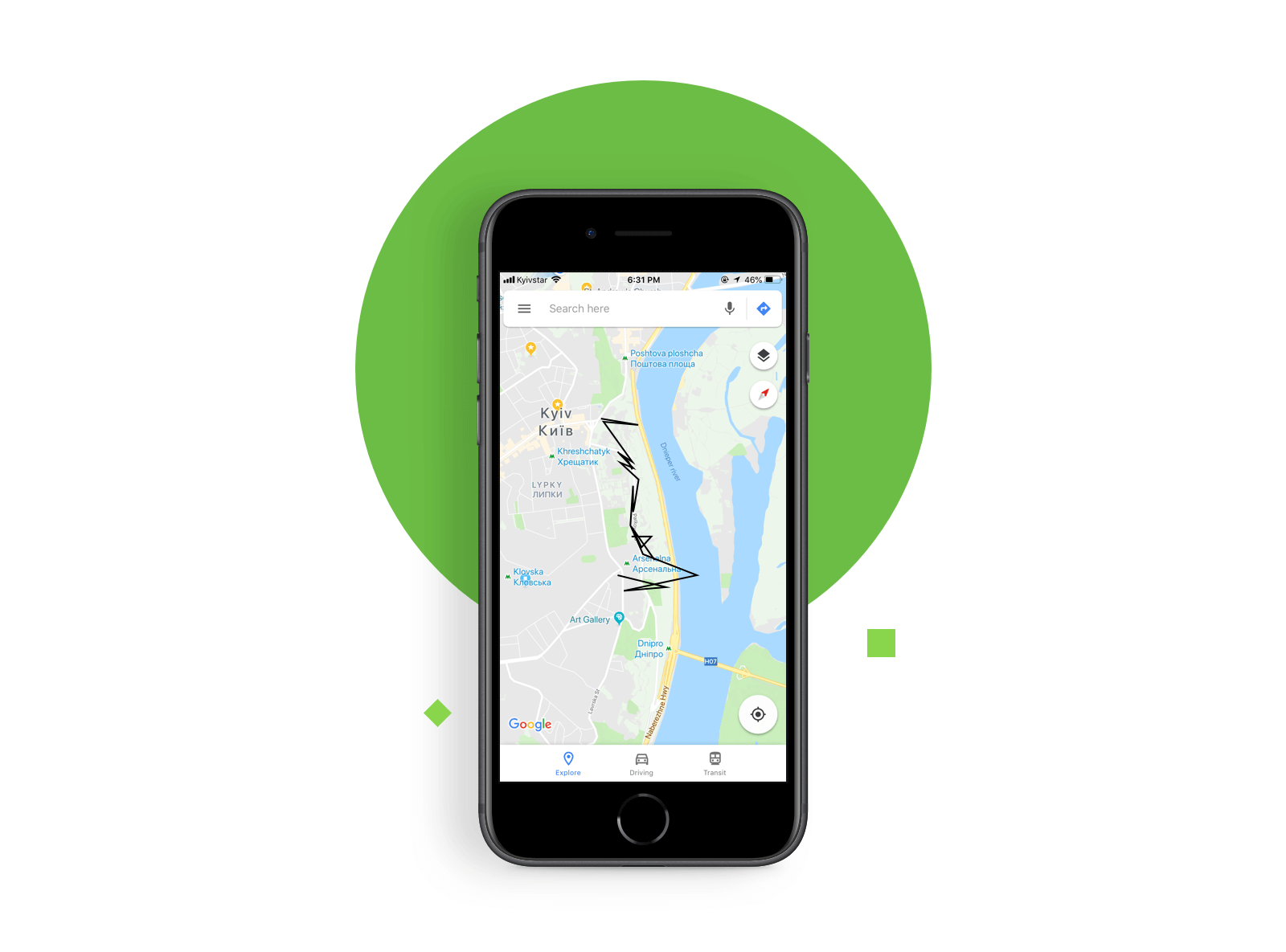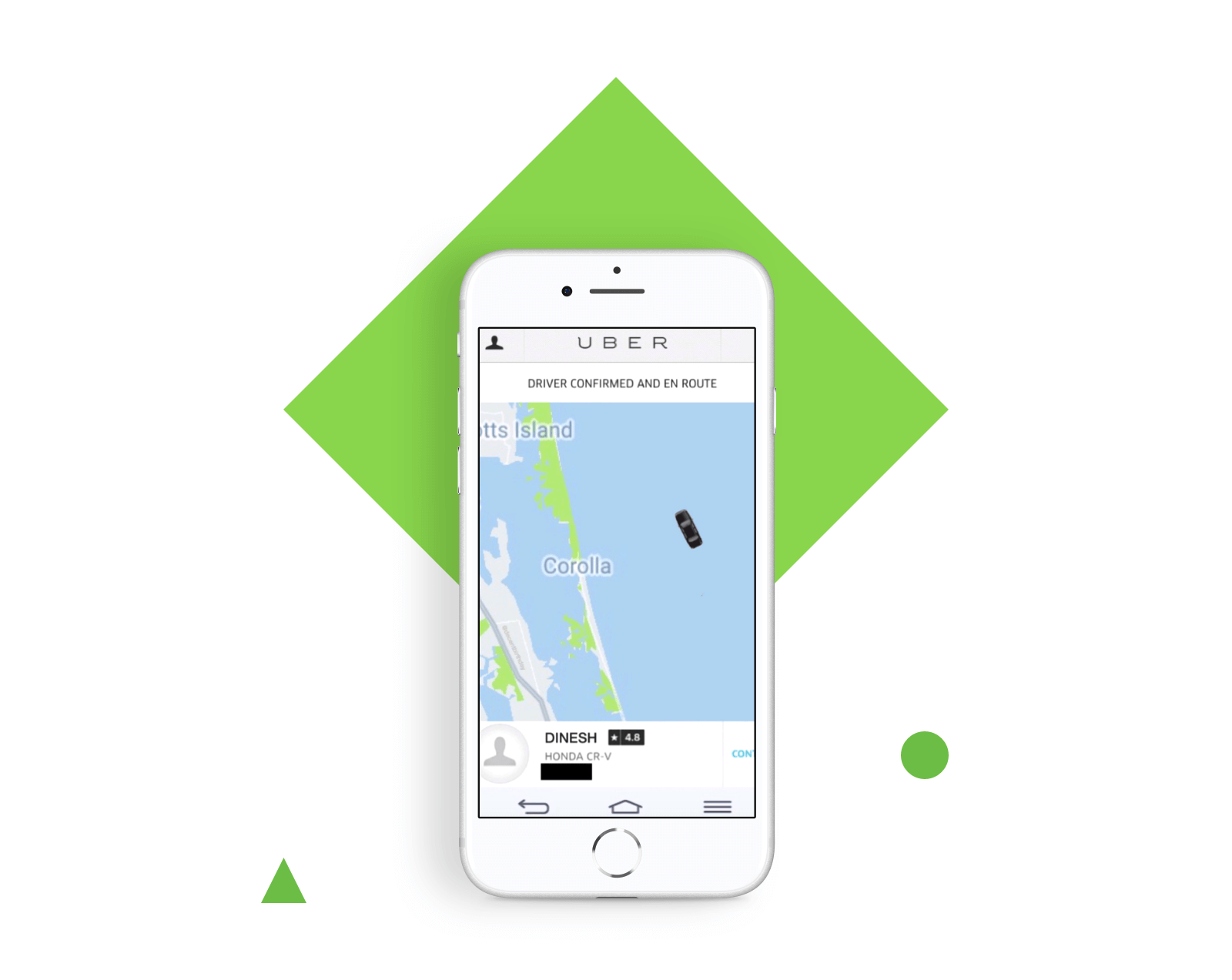In this post, we take a look at how to use React Native to build an application that can determine a user’s location via an API.
How does Uber always know the pickup location? Or how can Tinder find dates within a two-mile radius from you? It’s simple – you allowed them to know your location.
Location-based apps use customers’ locations to function and control different features. From pizza delivery and taxi to Find My iPhone and displaying the bus schedule, location-based applications have been helping us out with our everyday tasks.
Location might be either the primary function, like in Uber, or auxiliary, like in Facebook – it always tells you when there is an upcoming event near you. Whether it’s primary function or not, location helps improve user experience.

In this article, we will tell you about the main components of location-based apps and how to develop one using the React Native framework. First, we will study what React Native is and compare it to native app development. Then we will share approaches to gathering and displaying the location in an app. And finally, we will examine the design challenges and the ways to solve them.
Tools for Location-Based Service Development: Native vs. React Native
React Native is an open source JavaScript framework created by Facebook that allows developers to create cross-platform apps with their native behavior.
What do we mean by behavior? Let me explain. iOS and Android are different – they look different, their buttons are different, the common gestures are different. Developing an app for iOS and Android would require building two separate apps. It used to be a time-consuming process, but now we can write a single code base and it will work well on both platforms.
This helps businesses offer their app to both iOS and Android users, which increases the potential customer base. React Native is a popular choice for new companies that cannot afford building two separate apps or are unsure whether their audience uses iOS or Android. Taking into account that the cross-platform market is likely to grow to $80 billion by 2020, it makes perfect sense for many businesses to opt for React Native.
Now we are moving to the pros and cons of React Native. It is not an almighty and all-powerful framework, but there are definite cases when you should use it.
React Native Pros
- Cross-platform. Instead of writing a separate code base for each platform, you can use the same code for both iOS and Android. This also means you do not have to design different UIs and UXs.
- High performance. React Native uses native controls and modules. It interacts with the native iOS and Android components and renders code to the native API. The native API is the core here – by using a separate thread from the UI, it increases app performance.
- Open source. The React Native community is growing fast, and so is the number of available components. This lets developers share their experience, improve the framework, find solutions to existing bugs, and therefore make the development process faster.
- It saves money. As a result of the three previous points, using React Native saves you money. It is faster than building two separate apps and it takes less time on testing and releasing an MVP.
However, there are a few reasons when you might not want to use React Native. They include:
- You do not need a cross-platform app. If you know what OS your audience uses, I suggest you use native development. First, the app will be tailored to fit the specifics of the chosen OS, and second, you will be able to use platform-specific features.
- You need access to more APIs than React Native can offer. The framework does not support all native platform APIs. One core reason why many prefer native code is independence from third-party services because everything can be accessed through native frameworks.

How to Gather and Display User Location
In this part, we will tell you about the ways to gather and display location data. The choice usually depends on the specifics on the app being developed.
Gathering Location Data
We will point out three ways to gather a user’s location. This is a generic overview for you to understand when to opt for each and the differences between them.
Use React Native API
There is a native JavaScript API for detecting the geolocation of a device. It is simple to install and use, but there are some drawbacks – it works only when the app is running and does not give information about the location provider (3G, Wi-Fi, GPS).
react-native-background-geolocation
It is a package that can specify the location of a device from 0 to 1000 meters (0.6 miles). Such precision requires higher battery consumption, but, on the other hand, you can configure how often to track the location. This package lets you integrate with SQLite so that you can store the recorded location data on the mobile device and then sync it to your database via HTTP.
import { NativeModules, DeviceEventEmitter, PermissionsAndroid } from 'react-native'
import Config from 'react-native-config'
import get from 'lodash/get'
const { GeoLocation } = NativeModules
class BackgroundGeoLocation {
constructor(token, user_id) {
this.state = null
}
start(dispatch, nextState) {
this.dispatch = dispatch
const token = get(nextState, 'session.data.token')
const user_id = get(nextState, 'user.data.user_id')
const id = get(nextState, 'user.data.id')
this.state = {
user_id,
token,
}
return PermissionsAndroid.check(PermissionsAndroid.PERMISSIONS.ACCESS_COARSE_LOCATION)
.then(is_granted => is_granted === PermissionsAndroid.RESULTS.GRANTED
? is_granted
: PermissionsAndroid.requestMultiple([
PermissionsAndroid.PERMISSIONS.ACCESS_FINE_LOCATION,
PermissionsAndroid.PERMISSIONS.ACCESS_COARSE_LOCATION,
])
)
.then(_ => PermissionsAndroid.check(PermissionsAndroid.PERMISSIONS.ACCESS_COARSE_LOCATION))
.then(is_granted => is_granted === PermissionsAndroid.RESULTS.GRANTED ? true : new Error())
.then(_ => setTimeout(() => GeoLocation.startService(token, user_id, id, `${Config.API_URL}/live/car-tracking/gps-pos/`), 300))
.catch(e => console.log(e))
}
stop() {
return GeoLocation.stopService()
.then(_ => console.log(_))
}
handleLocationChange(geo) {
console.log(geo)
}
}
export default BackgroundGeoLocation
Since it is a package, you need to maintain and update it regularly. Luckily, its creator offers support via GitHub. This package is free for iOS but costs $300 for Android for one app.
Bridge Native Code to the JavaScript API
To solve the problem with background tracking when using the native JavaScript API, you can write native code that will start a foreground service in a separate thread. That’s exactky what we did when developing our food delivery product, Azyan. Partly, we chose this way because React Native made it easy to bridge native code to React Native components.
import { NativeModules, DeviceEventEmitter, PermissionsAndroid } from 'react-native'
import Config from 'react-native-config'
import get from 'lodash/get'
const { GeoLocation } = NativeModules
class BackgroundGeoLocation {
constructor(token, user_id) {
this.state = null
}
start(dispatch, nextState) {
this.dispatch = dispatch
const token = get(nextState, 'session.data.token')
const user_id = get(nextState, 'user.data.user_id')
const id = get(nextState, 'user.data.id')
this.state = {
user_id,
token,
}
return PermissionsAndroid.check(PermissionsAndroid.PERMISSIONS.ACCESS_COARSE_LOCATION)
.then(is_granted => is_granted === PermissionsAndroid.RESULTS.GRANTED
? is_granted
: PermissionsAndroid.requestMultiple([
PermissionsAndroid.PERMISSIONS.ACCESS_FINE_LOCATION,
PermissionsAndroid.PERMISSIONS.ACCESS_COARSE_LOCATION,
])
)
.then(_ => PermissionsAndroid.check(PermissionsAndroid.PERMISSIONS.ACCESS_COARSE_LOCATION))
.then(is_granted => is_granted === PermissionsAndroid.RESULTS.GRANTED ? true : new Error())
.then(_ => setTimeout(() => GeoLocation.startService(token, user_id, id, `${Config.API_URL}/live/car-tracking/gps-pos/`), 300))
.catch(e => console.log(e))
}
stop() {
return GeoLocation.stopService()
.then(_ => console.log(_))
}
handleLocationChange(geo) {
console.log(geo)
}
}
export default BackgroundGeoLocation
Permission to Access Location Data
Despite having to upgrade React Native with native code, we decided to keep on using React Native for its ease with getting permission for using location information. Here is why it could cause troubles.
Different platforms may require permission to access the location data on different steps: on iOS, the permission is requested the first time you open an app; on Android, it is requested upon downloading the app. If using native code, we would need to take this into account. But React Native simplifies this process using the check access to location data module. It verifies the access to location data without triggering the permission alert.
Displaying Location
If not approached carefully, the location data may be displayed inaccurately. The device gathers data about its current location from three sources: GPS, Wi-Fi, and cellular network (3G, 4G). Since Wi-Fi and cellular data are more accurate than GPS (the signal from the device to the satellite may be distorted), the device is constantly checking whether there is an Internet connection. If so, the location data comes from it. If not, it uses GPS. When getting inaccurate data, we may observe zigzags on a map rather than straight lines. It looks something like this:

To solve this problem, we suggest you use Fused Location Client by Google. It allows you to set the time and distance at which the location data is updated; e.g., update the data every 100 meters, every 5 seconds. You will get rid of the noisy data as this API matches all device locations to roads and sidewalks. However, if the device is somewhere in the Pacific or the Alps, it may not be that effective.

Fused Location Client allows one to not display certain locations in which accuracy is lower than a set threshold. Such an adjustment results in noise reduction and more accurate display of locations.
A Few Words About Design
In this brief section, we will study the obstacles that usually arise when developing a location-based application and how React Native overcomes those obstacles.
React Native allows simple approaches to displaying maps. React Native UI components for Material Design let developers work faster and with less effort. We used Material Design to create a Google Maps wrapper and then React Native would adjust them to the specifics of each platform.
Infinite List is a React Native feature that creates an endless list of search results. In Uber, the endless list appears when you start typing the destination point. If you start typing 3 Ave, it will show all Third Avenues around you. The list is not actually endless; it is just that it loads more search results as users scroll down.
import { NativeModules, DeviceEventEmitter, PermissionsAndroid } from 'react-native'
import Config from 'react-native-config'
import get from 'lodash/get'
const { GeoLocation } = NativeModules
class BackgroundGeoLocation {
constructor(token, user_id) {
this.state = null
}
start(dispatch, nextState) {
this.dispatch = dispatch
const token = get(nextState, 'session.data.token')
const user_id = get(nextState, 'user.data.user_id')
const id = get(nextState, 'user.data.id')
this.state = {
user_id,
token,
}
return PermissionsAndroid.check(PermissionsAndroid.PERMISSIONS.ACCESS_COARSE_LOCATION)
.then(is_granted => is_granted === PermissionsAndroid.RESULTS.GRANTED
? is_granted
: PermissionsAndroid.requestMultiple([
PermissionsAndroid.PERMISSIONS.ACCESS_FINE_LOCATION,
PermissionsAndroid.PERMISSIONS.ACCESS_COARSE_LOCATION,
])
)
.then(_ => PermissionsAndroid.check(PermissionsAndroid.PERMISSIONS.ACCESS_COARSE_LOCATION))
.then(is_granted => is_granted === PermissionsAndroid.RESULTS.GRANTED ? true : new Error())
.then(_ => setTimeout(() => GeoLocation.startService(token, user_id, id, `${Config.API_URL}/live/car-tracking/gps-pos/`), 300))
.catch(e => console.log(e))
}
stop() {
return GeoLocation.stopService()
.then(_ => console.log(_))
}
handleLocationChange(geo) {
console.log(geo)
}
}
export default BackgroundGeoLocation
In React Native, there is a ready interface component, Flat List, that has a fixed header, footer, and delimiters. Creating such lists from scratch is a time-consuming activity, so React Native is the right choice for this functionality.
Bottom Line
We have studied why React Native might be the right choice if you are going to build a location-based application. We have also identified the main methods to gather and display the location on a device.
We have listed the main advantages of developing an app using React Native. If most of them are true for you, we suggest you do deeper research on the technology and its possibilities.
We now encourage you to pay more attention to the apps that are using device location. You may be surprised that most apps you know of ask you to allow them access to your location. For many businesses, it is crucial to know your location to deliver the best service. Google, Facebook, Airbnb, Amazon – all of them use location as a basis for some of their functionality: where to search, where to stay, where to ship. If used properly, location data allows to make the service more user-oriented and efficient.
#reactjs #react-native #web-development
